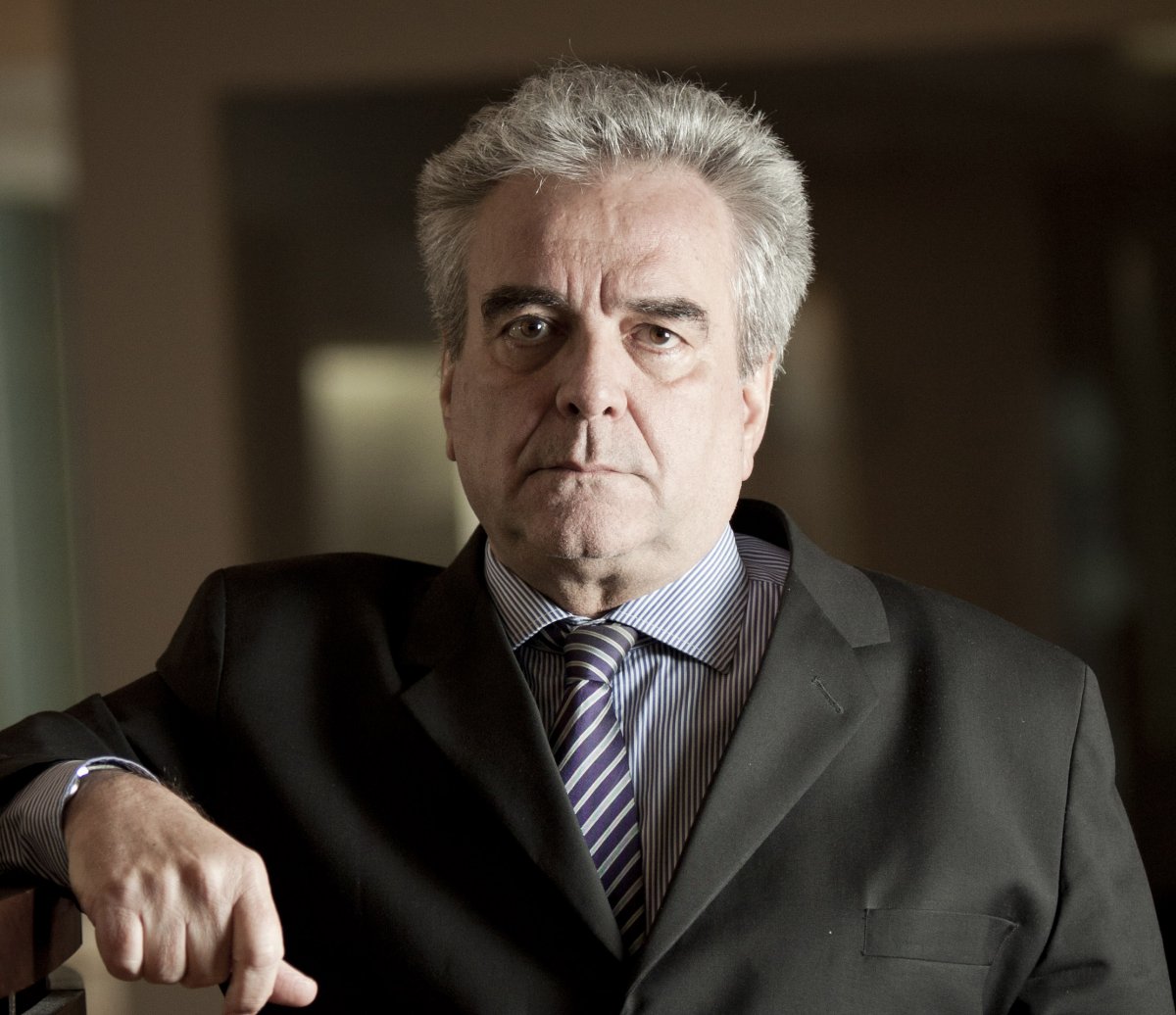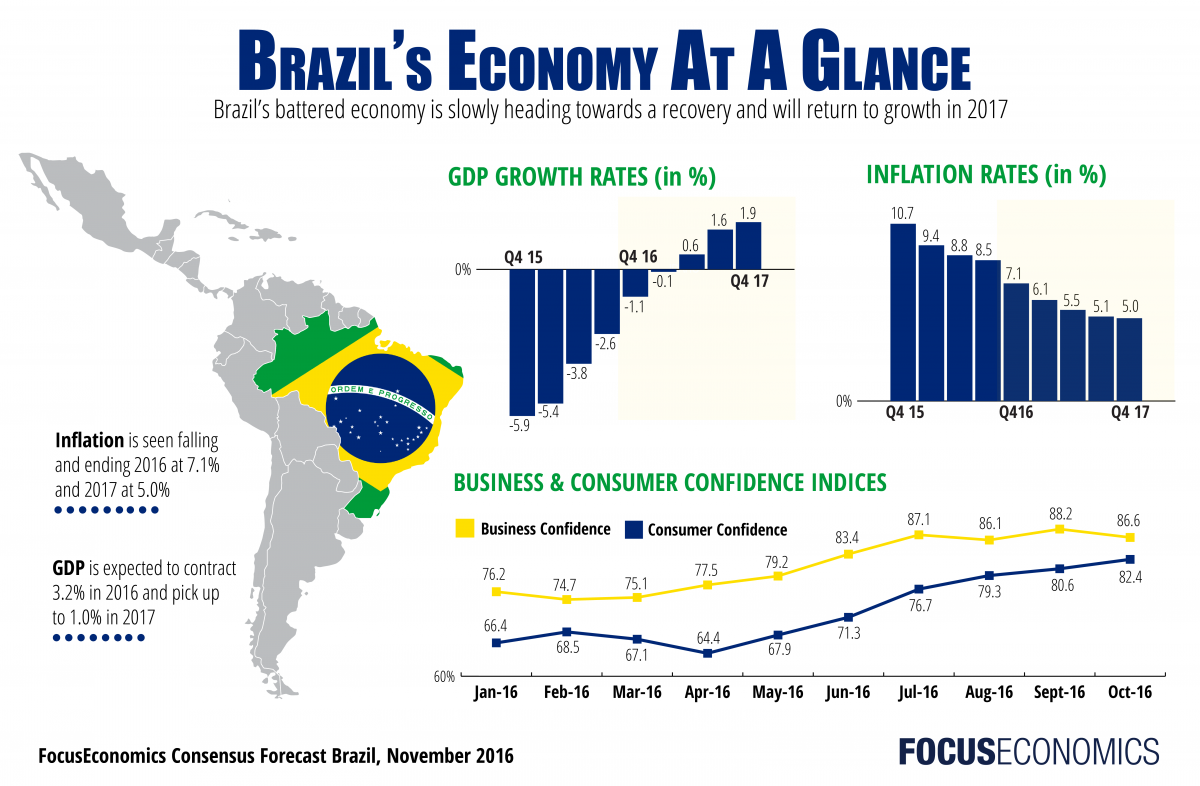
FocusEconomics: How has the political and economic environment changed over the last few months and what is your outlook for 2017?
José Francisco Gonçalves: In mid-2016, I was amongst the consensus economists. We were expecting the economy to stabilize sometime between the third and the fourth quarters and to resume growth by the second quarter of 2017. But we were surprised by the feeble activity during the third quarter, which was broad-based. Also, though this was less of a surprise, tax income continued to fall and spending to rise, on the back of increases in unemployment. Confidence indicators also worsened after having improved somewhat. Looking ahead, 2017 will be a difficult year. Domestic political and ethical crises will not end anytime soon and are clearly constraining the economy. And this is before we add Trump into the mix…
FE: Our panel of 38 economists forecast that the Brazilian economy will expand 1.0% next year. Are your forecasts in line with the consensus?
JFG: We have recently cut our forecast for GDP growth in 2017 from 1.2% to zero growth. In fact, recent developments in both the political and economic environment (see above) have made us relatively more downbeat. The labor market will still worsen, credit may stabilize but will not increase, and net exports will contribute with a very small push. The only good news, although due to high unemployment, is that inflation is headed down. And this creates ample space for the Central Bank to strongly reduce the interest rate.
FE: After Dilma’s impeachment, will Brazil continue to make improvements in reducing its culture of systemic corruption?
JFG: Recent developments confirm the favorable trend. Operation Lava Jato is being continued with clear support from the populace and the media. There are ups and downs in its management, but I think institutions are solid and able to deal with Brazil’s problems.
FE: Will Eduardo Cunha’s arrest undermine Michel Temer’s support in Congress?
JFG: Temer’s support rests largely on the Brazilian Democratic Movement Party (PMDB), a party that is a federation of local and regional interests. They have been present at all levels of public administration and Congress since the redemocratization of the mid-80s. Cunha is not the only, nor the most relevant, supporter of Temer in trouble. There’s a clear downside risk for the government and the economy here.
FE: Could you comment on the other Temer supporters in trouble? Who do you think is most relevant and what events are you watching for political stability? Do you think there is a chance of early elections?
JFG: Early elections are possible, but not our basic scenario. We are facing a complex process that nobody is in control of, but I don’t see how such elections would favor any of the key figures in politics at the moment. We monitor, as far as possible, events regarding Lava Jato and bills being voted in the Congress. There’s a relationship between the ongoing investigation, lawmakers’ trials to defend themselves and parliamentary activity. MPs are often caught between a rock and a hard place when seeking to approve bills of government interest.
FE: Do you think the Brazilian government or Senate will pass the spending cap by year-end? Do you see any potential holdups or negative consequences from the bill?
JFG: I expect the Senate to approve the bill by year-end, but it will not be the solution that some people expect. It is obvious that something needs to be done, and capping any increase in spending below GDP growth could be an alternative. On the other hand, however, I agree with the view that there is a risk of entering a vicious spiral if expense cuts lead to less activity and then lower tax collection, etc. So it will be crucial for the infrastructure investment program to take off and boost the economy, but this requires adequate regulation and funding. It’s not reasonable to wait for a package of infrastructure investment with the real ex-ante Selic at 8%.
Click on the image to open a full-size version
FE: Otaviano Canuto, Executive Director at the World Bank, has recently stated that “Brazil has been suffering from anemic productivity growth.” Do you agree with this statement and if so, what actions can be undertaken to sustain productivity increases in the long run?
JFG: Productivity depends on some long-term factors such as education. But this is not a panacea. Improving education patterns is almost useless if there’s no investment to incorporate new technologies into the productive process. So, access to state-of-the-art technology, as well as financing and other competitiveness determinants (exchange rate, scale), must be established in order to recover productivity.
General production conditions also need to be improved. Efficient infrastructure logistics and safe energy supply are required to create an adequate environment for investment decision making, as well as a stable macroeconomic environment.
On the other hand, there’s plenty of room for more productivity gains resulting from microeconomic and fiscal reforms (e.g. reforming the tax system and reducing public expenses). Regulatory issues are also critical. A look at the World Bank’s Doing Business in Brazil report clearly points to the long road ahead.
FE: Do you see the government being able to pass a pension reform next year? What elements would you like to see in the bill?
JFG: I think a pension reform in some shape or form will be approved by mid-2017, since capping public spending would be useless without including social security in the areas to be cut. Indeed, the main problem is not spending on personnel or suppliers, or even transfer payments. A pension system that adjusts both to our demographic needs and to cyclical swings is much needed. The first issues to resolve are the minimum age to retire and the indexation that should be used to update retirement benefits. This should allow credible projections of the social security accounts to be produced.
FE: How do you see the SELIC rate moving over the next year and at what pace do you expect the Central Bank to ease? Has the recent market and exchange rate volatility affected your forecast?
JFG: We revised our expected Selic trend after the last COPOM decision a month ago. Then, against our expectations, the committee reduced the policy rate by 0.25%, on the back of external uncertainty, slow fiscal progress and a lower-than-expected decline in services prices. They should maintain the pace of easing next week, thus we postponed the increase in the pace of reduction of the Selic to January’s meeting. Recent developments don’t look likely to change our outlook, for we had already anticipated an exchange rate of R$ 3,20 (November FocusEconomics Consensus) and of a revised R$ 3,38 (current).
However, we still understand that the rate will fall faster due to an increase in the nominal deficit and that there is a growing risk of the economy stabilizing without signs of recovery. We expect the rate to reach 9.75% by October.
Sample Report
5-year economic forecasts on 30+ economic indicators for 127 countries & 33 commodities.
